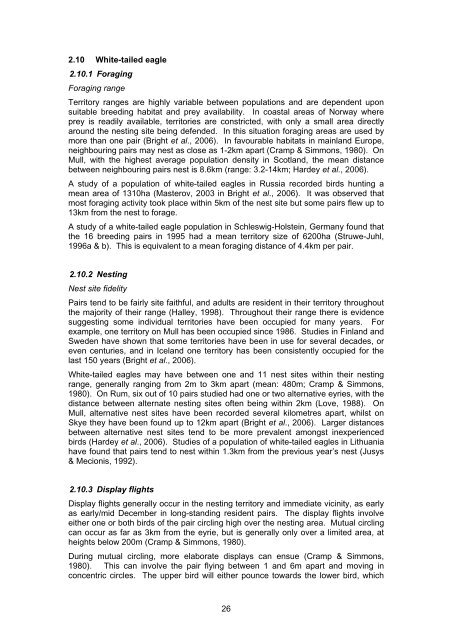Literature review to assess bird species connectivity to Special ...
Literature review to assess bird species connectivity to Special ...
Literature review to assess bird species connectivity to Special ...
Create successful ePaper yourself
Turn your PDF publications into a flip-book with our unique Google optimized e-Paper software.
2.10 White-tailed eagle<br />
2.10.1 Foraging<br />
Foraging range<br />
Terri<strong>to</strong>ry ranges are highly variable between populations and are dependent upon<br />
suitable breeding habitat and prey availability. In coastal areas of Norway where<br />
prey is readily available, terri<strong>to</strong>ries are constricted, with only a small area directly<br />
around the nesting site being defended. In this situation foraging areas are used by<br />
more than one pair (Bright et al., 2006). In favourable habitats in mainland Europe,<br />
neighbouring pairs may nest as close as 1-2km apart (Cramp & Simmons, 1980). On<br />
Mull, with the highest average population density in Scotland, the mean distance<br />
between neighbouring pairs nest is 8.6km (range: 3.2-14km; Hardey et al., 2006).<br />
A study of a population of white-tailed eagles in Russia recorded <strong>bird</strong>s hunting a<br />
mean area of 1310ha (Masterov, 2003 in Bright et al., 2006). It was observed that<br />
most foraging activity <strong>to</strong>ok place within 5km of the nest site but some pairs flew up <strong>to</strong><br />
13km from the nest <strong>to</strong> forage.<br />
A study of a white-tailed eagle population in Schleswig-Holstein, Germany found that<br />
the 16 breeding pairs in 1995 had a mean terri<strong>to</strong>ry size of 6200ha (Struwe-Juhl,<br />
1996a & b). This is equivalent <strong>to</strong> a mean foraging distance of 4.4km per pair.<br />
2.10.2 Nesting<br />
Nest site fidelity<br />
Pairs tend <strong>to</strong> be fairly site faithful, and adults are resident in their terri<strong>to</strong>ry throughout<br />
the majority of their range (Halley, 1998). Throughout their range there is evidence<br />
suggesting some individual terri<strong>to</strong>ries have been occupied for many years. For<br />
example, one terri<strong>to</strong>ry on Mull has been occupied since 1986. Studies in Finland and<br />
Sweden have shown that some terri<strong>to</strong>ries have been in use for several decades, or<br />
even centuries, and in Iceland one terri<strong>to</strong>ry has been consistently occupied for the<br />
last 150 years (Bright et al., 2006).<br />
White-tailed eagles may have between one and 11 nest sites within their nesting<br />
range, generally ranging from 2m <strong>to</strong> 3km apart (mean: 480m; Cramp & Simmons,<br />
1980). On Rum, six out of 10 pairs studied had one or two alternative eyries, with the<br />
distance between alternate nesting sites often being within 2km (Love, 1988). On<br />
Mull, alternative nest sites have been recorded several kilometres apart, whilst on<br />
Skye they have been found up <strong>to</strong> 12km apart (Bright et al., 2006). Larger distances<br />
between alternative nest sites tend <strong>to</strong> be more prevalent amongst inexperienced<br />
<strong>bird</strong>s (Hardey et al., 2006). Studies of a population of white-tailed eagles in Lithuania<br />
have found that pairs tend <strong>to</strong> nest within 1.3km from the previous year’s nest (Jusys<br />
& Mecionis, 1992).<br />
2.10.3 Display flights<br />
Display flights generally occur in the nesting terri<strong>to</strong>ry and immediate vicinity, as early<br />
as early/mid December in long-standing resident pairs. The display flights involve<br />
either one or both <strong>bird</strong>s of the pair circling high over the nesting area. Mutual circling<br />
can occur as far as 3km from the eyrie, but is generally only over a limited area, at<br />
heights below 200m (Cramp & Simmons, 1980).<br />
During mutual circling, more elaborate displays can ensue (Cramp & Simmons,<br />
1980). This can involve the pair flying between 1 and 6m apart and moving in<br />
concentric circles. The upper <strong>bird</strong> will either pounce <strong>to</strong>wards the lower <strong>bird</strong>, which<br />
26

















